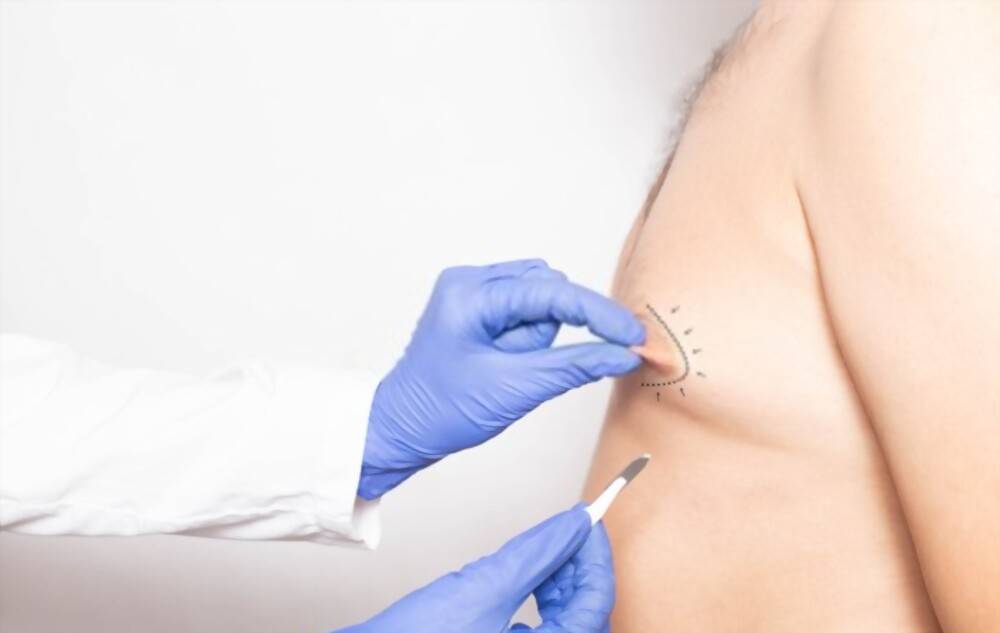Gynecomastia
The medical term gynecomastia is the development of abnormal breast tissue in men. It refers to the benign growth of mammary gland tissue in male breasts. Inside names are gynos or bitch tits. In this article, we will dive into the world of gynecomastia. We will discuss all the topics related to this with great focus on the gynecomastia pinch test.
It can occur at all ages. It is not a rare phenomenon at birth, during puberty, and at a later age (above 60 years). At birth, quite a few boys have some breast tissue due to the high level of female sex hormones just before birth.
More than half of male adolescents have temporary gynecomastia. These forms are harmless and usually go away on their own. However, persistent gynecomastia can be a sign of illness and should always be investigated further. In the majority of cases, breast augmentation occurs on both sides. This is called bilateral.
Causes of gynecomastia
In a quarter of the cases, it is not known what causes gynecomastia. In the medical literature the following causes are mentioned:
- Puberty
- Drug use (eg steroids, prohormones)
- Liver cirrhosis (liver shrinkage)
- Malnutrition
- Hypogonadism (deficiency of male sex hormones)
- Tumors of the testicles
- Overactive thyroid and kidney disease
Among all these cases there is an imbalance in male and female sex hormones, resulting in relatively more estrogens in the body. This ‘excess’ of estrogens, therefore, causes unwanted breast growth. Other effects of excess estrogen are increased fluid retention and fat storage.
As there are several factors that can cause the problem. A gynecomastia pinch test will not always decide the special cause which is often unknown.


Gynecomastia Pinch Test
It is always the best option to visit the doctor if you are experiencing a problem with your breast. Diagnosis is the quick and easy way to see whether you are at risk of developing the problem or not. The doctor will examine whether the symptoms are caused by physiologic factors or drugs.
The doctor performs a gynecomastia pinch test to determine whether the condition is gynecomastia or pseudogynecomastia.
For an accurate diagnosis of gynecomastia, your doctor will require your medical history. After reviewing your medical history, you will be asked to lay down on your back. All the things the doctor needs for a gynecomastia pinch test are some paper and some pressure.
He will use his thumb and forefingers to examine the breast tissues. He will apply pressure for about 2 seconds on your nipples. If any changes occur in breast size or shape, the condition is true gynecomastia. If there is no rubbery mass of disk-shaped tissue beneath the nipple. Your doctor can determine that the problem is pseudogynecomastia.
How do You Know If You Have Gynecomastia?
If you’re worried or concerned about your gynecomastia. The simple way to determine the problem is the gynecomastia pinch test. The procedure involved in the diagnosis is mentioned above. To self-diagnose, place your fingers around the chest and apply pressure gently.
If you feel any pain while applying pressure, it’s likely that you have the problem. There are many treatment options available for those who want to address their problem. Medications and surgical options are available to treat Gynecomastia. These include anabolic steroids and finasteride e.g., gynectrol and phen375.
In some cases, you have to change your lifestyle by avoiding alcohol and eating a healthy diet.
How do you do the gynecomastia pinch test yourself?
It is always the best option to contact your health professional when you have any health problem. However, if you are wondering about self-diagnosis, here are some steps.
By following these easy steps, you can perform a gynecomastia pinch test. But visiting the doctor is always best because you cannot professionally diagnose.
You need to collect some items such as a sturdy book, a ruler, and a cup.
- Measure the distance with the help of a ruler from your collarbone to the tip of your breast. Compare this measurement to the exact size provided in the book. If this distance falls within the range of normal, you are not at the risk of a problem.
- If it is outside of the given normal range, you may have gynecomastia. Moreover, you still need to diagnose any other problem related to your health. So, contact a board-certified doctor as soon as possible for diagnosis and treatment.
- Complete your gynecomastia pinch test every six months if you are at risk of the problem. This will help to determine any course of treatment and monitor your condition.
Advantages of Gynecomastia Pinch Test
Here are the following advantages of Gynecomastia Pinch Test:
- Non-invasive: The test is a simple and non-invasive test that can be performed easily.
- Quick: The test takes just a few seconds to perform, making it quick and convenient.
- Painless: Unlike other diagnostic tests, this test is completely painless.
- Affordable: The test is relatively cheap and affordable.
- Accurate: The test provides accurate results, making it a reliable diagnostic tool.
- Easy to Interpret: The results of the test are easy to interpret.
- Convenient: The test is convenient can be performed in the privacy of one’s own home.
- No Preparation Required: This test do not need any preparation before performing.
- No Equipment Needed: The test requires no special equipment.
- The test can be repeated multiple times, allowing for a more accurate diagnosis.
Symptoms you may experience
For people experiencing any of the following symptoms, it is possible that they have gynecomastia. The common symptoms are:
- Swollen or Painful breast
- Breast Tenderness
- Increase in the chest size
- Moveable tissue beneath the nipple
- The appearance of bloody discharge from the nipple
- Itchiness in the nipple
If you are experiencing any of the symptoms, it is important to discuss them with a health professional.
Conclusion of Gynecomastia Pinch Test
The gynecomastia pinch test is an easy, quick, and effective way to determine gynecomastia. If you are at risk of developing this problem, the first step is a diagnosis by using a pinch test.
If you have any additional questions related to this contact us by using a contact form. Our professional team is always available to help you, do not hesitate and feel free to contact us. Stay healthy!







